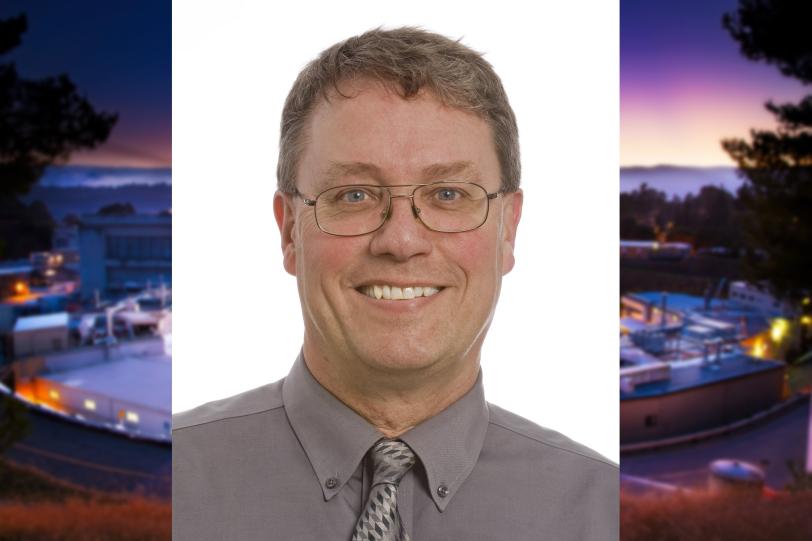Graham George receives Lytle Award for contributions to X-ray absorption spectroscopy
In more than 185 experimental runs at SLAC’s synchrotron, he has pushed the envelope of both techniques and science.
By Aiko Takeuchi-Demirci
Graham Neil George, professor and Canada Research Chair in X-ray Absorption Spectroscopy (XAS) at the University of Saskatchewan, has been chosen to receive the 2018 Farrel W. Lytle Award for his outstanding contributions to synchrotron science at the Department of Energy’s SLAC National Accelerator Laboratory.
The award was established by the Stanford Synchrotron Radiation Lightsource Users’ Executive Committee (SSRLUEC) to promote technical or scientific accomplishments in synchrotron radiation-based science. It is given each year to a scientist or a staff member in recognition of their work at SSRL, which is a DOE Office of Science user facility.
The people who nominated George all agreed that he is “more than qualified” and “long overdue” for this recognition. “He has always pushed the envelope of the technology and made impactful scientific contributions to many fields,” wrote Robert Scott, former Lytle Award winner, in his letter of endorsement.
George has been associated with SSRL in one way or another since 1983 – as a user, postdoctoral fellow, visiting scholar, physicist, and most recently as a laboratory affiliate during a sabbatical in 2015. He is an active SSRL user and serves as vice chair of the SSRL Users Executive Committee. He has taken part in over 185 different experimental runs at SSRL and published more than 249 papers based on SSRL data, which collectively have been cited nearly 12,000 times (source: Scopus). That’s more than two-thirds of his publications, according to his younger brother, Simon George, also an established spectroscopist, who added: “He is tireless in his advocacy for both SSRL and synchrotron radiation science.”
In 2016 George was elected a Fellow of the Mathematical and Physical Sciences Division of the Royal Society of Canada, Canada’s senior National Academy.
Chemistry matters
George is a leader in what is called structural enzymology - using X-ray spectroscopy to understand reaction mechanisms in metalloenzymes. These enzymes are protein molecules that contain metal ions at the heart of functional centers to facilitate chemical reactions in living cells. Much of George’s recent work has focused on molybdenum- and tungsten-containing metalloenzymes. Additionally, one of his recent projects involves understanding the role of copper in Alzheimer’s disease through XAS.
While George is recognized primarily for his work on biological compounds, he is also a pioneer in applying XAS to tackle important environmental issues, such as elements of environmental concern in oil, coal and water.
As a former researcher at Exxon Research and Engineering Company, George used XAS to measure the properties of various forms of sulfur-containing molecules in coals and to remove the problematic ones. Sulfur present in fossil fuels can react with metals in equipment and damage it. This early work was rewarded with an American Chemical Society Award in 1990. More recently, George teamed up with researchers from Chevron for a close examination of sulfur compounds in crude oil to better predict corrosion rates in refinery pipelines.
In another series of X-ray experiments at SSRL, George and his wife Ingrid Pickering, also professor at the University of Saskatchewan and an SSRL user, demonstrated a linkage between the toxicology of arsenic and selenium in mammalian tissues. Their research could potentially have a huge impact on the health of millions of people poisoned by arsenic from contaminated water.
George’s recent experiments employ a new technique called advanced X-ray spectroscopy, which dramatically improves energy resolution and allows deeper insight into the chemical structure of specimens being studied. SSRL is one of the few laboratories in the world with facilities optimized for advanced X-ray spectroscopy experiments on dilute samples.
“This is a relatively untouched field with enormous potential, and we’re excited by the possibilities,” George said.
‘Another excellent thing’
Farrel Lytle, the X-ray spectroscopy pioneer whom the award is named after, came to know George when George started to do experiments at SSRL in the mid-1980s while working for Exxon. “We were very impressed with him,” Lytle recalled.
George said, “The award is especially noteworthy for me because it is named for one of my scientific heroes, Farrel Lytle.” He described Lytle, as well as the broader faculty and staff at SSRL, as having “a can-do attitude, with focus and energy for the task in hand, which means that things get done and get done well.”
“While I feel distinctly honored by this recognition, I also feel slightly uncomfortable,” George said. “This arises from the fact that SSRL and SLAC have really given me so much over the years, both in terms of research opportunities and good friends, that I feel uncomfortable and somewhat undeserving about being given yet another excellent thing.”
Lytle, who has no part in the selection process, said he is pleased with the committee’s decision. “This award has turned out to be a desirable mark of recognition because of the quality of the people who have been chosen,” he said.
The award will be presented by SSRL UEC Chair Dave Bushnell at the 2018 SSRL/LCLS Annual Users’ Meeting at SLAC on September 26.
For questions or comments, contact the SLAC Office of Communications at communications@slac.stanford.edu.
SLAC is a multi-program laboratory exploring frontier questions in photon science, astrophysics, particle physics and accelerator research. Located in Menlo Park, Calif., SLAC is operated by Stanford University for the U.S. Department of Energy's Office of Science.
SLAC National Accelerator Laboratory is supported by the Office of Science of the U.S. Department of Energy. The Office of Science is the single largest supporter of basic research in the physical sciences in the United States, and is working to address some of the most pressing challenges of our time.






